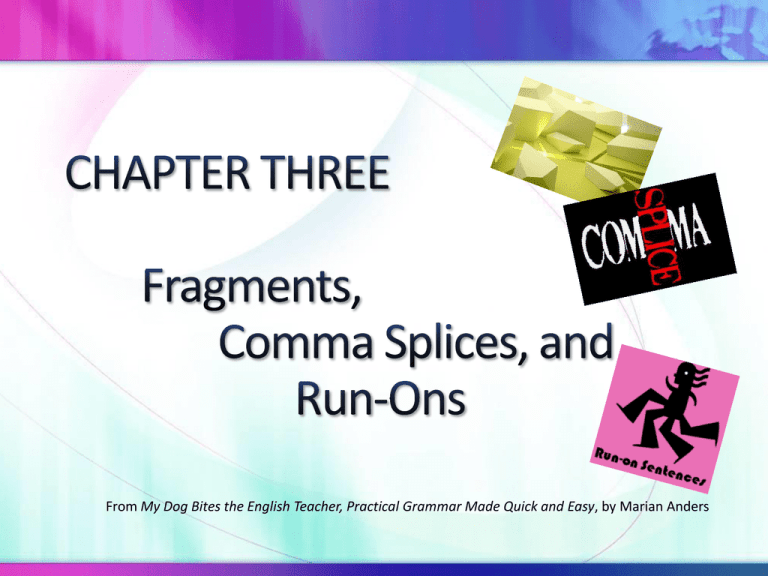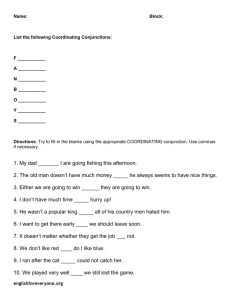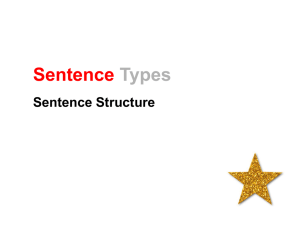Fragments, Clauses and Run-ons
advertisement

From My Dog Bites the English Teacher, Practical Grammar Made Quick and Easy, by Marian Anders Fragments, comma splices, and run-ons are the most common mistakes that people make in their writing. In this lesson you will learn how to identify these mistakes and then how to fix them. •Think of some words that begin with the prefix sub. Submarine subway •All of these things go under. The submarine goes under the water; the subway goes under the street. More words that begin with the prefix sub: Subservient submissive •These words describe someone who is less powerful. A person who is subservient or submissive willingly obeys someone else. •The prefix sub means under, less powerful. A subordinating conjunction is a word that goes at the beginning of a clause and makes the clause less powerful or dependent on another clause. Common Subordinating Conjunctions after before that unless although if though when as since till where because so that until while Independent and Dependent Clauses As you know, a clause is a group of words that has a subject and a verb. There are two kinds of clauses— dependent and independent—and they have different sounds. When you put a subordinating conjunction at the beginning of a clause, the clause will sound different. I ate dinner. After I ate dinner…… Say both of these clauses out loud and listen to how your voice sounds. I ate dinner. After I ate dinner…… When you say the first clause, the pitch of your voice goes down, and you sound like you’re finished talking. I ate dinner. This clause expresses a complete idea. After I ate dinner When you say this clause, the pitch of your voice goes up, and it sounds like you are going to continue speaking and tell what happened after you ate dinner. This clause does not express a complete idea. The listener is waiting for you to finish. After I ate dinner……what happened? A subordinating conjunction is a word that goes at the beginning of a clause and makes the clause sound unfinished. We will mark subordinating conjunctions with a wavy underline. A dependent clause is a clause that starts with a subordinating conjunction. It sounds unfinished and leaves the listener hanging. We will mark dependent clauses DC. An independent clause does not have a subordinating conjunction. It sounds complete. We will mark independent clauses IC. After I ate dinner, I washed the dishes. DC IC The first clause depends on the second clause to finish the idea. Sentence Fragments A sentence must have an independent clause. A sentence that doesn’t have an independent clause is called a fragment. Remember: An independent clause has a subject and a verb and it expresses a complete idea. Mario hit the winning run. Mario hit the winning run. IC The weather was cold. The weather was cold. IC Remember: A dependent clause also has a subject and a verb, but it leaves the reader hanging. A dependent clause begins with a subordinating conjunction that changes the sound of the clause. After Mario hit the winning run After Mario hit the winning run...what? DC Although the weather was cold Although the weather was cold…what? DC Remember: A phrase is any group of words that does not have a subject and a verb. in the morning in the morning Ph wore a blue suit wore a blue suit Ph Phrases and dependent clauses are important to our writing. They add details and make a sentence more interesting. But they cannot be sentences by themselves. FRAGMENTS ARE EVERYWHERE You will often see fragments in magazines, on billboards, and on your cereal box. If you are doing informal writing, go ahead and use fragments. For academic or business writing, it is better to write complete sentences. Process for Identifying Fragments Step 1) Change the time and listen for a verb. If you find a verb, double underline it and go on to the next step. If there is no verb, the sentence is a phrase. Mark F for fragment. Early in the morning. Early in the morning. F After Mark drove all night. After Mark drove all night. (Go to the next step) Process for Identifying Fragments Step 2) Next, look for a subject by asking “who?” If you find a subject, underline it and go on to the next step. If there is no subject, the sentence is a phrase. Mark F for fragment. Drove all night. Drove all night. F After Mark drove all night. After Mark drove all night. (Go to the next step.) Process for Identifying Fragments Step 3) If you have a verb and a subject, it is a clause. Now you must determine what kind of clause. Look for a subordinating conjunction. If you find one, underline it with a wavy line. If the clause has a subordinating conjunction, it is a dependent clause. Mark F for fragment. After Mark drove all night. After Mark drove all night. F Process for Identifying Fragments Step 4) If the clause does not have a subordinating conjunction, it is an independent clause. Mark OK for a correct sentence. Mark drove all night. OK TIME TO PRACTICE!!! From My Dog Bites the English Teacher, Practical Grammar Made Quick and Easy, by Marian Anders Now we need to learn how to FIX fragments. There are two ways to fix a fragment, and they both involve erasing something. First Method: You can erase a period and attach the fragment to a sentence that has an independent clause. In the morning. Sherry jogs three miles. Ph-fragment IC Erase the period to attach the fragment to a complete sentence: In the morning Sherry jogs three miles. Ph IC By joining the fragment to a complete sentence, you created one longer sentence. One independent clause is enough even for a very long sentence. Here's another example: She goes to the gym. After she finishes work. IC DC – fragment Erase the period to attach the fragment to the complete sentence. She goes to the gym after she finishes work. IC DC – fragment By joining the fragment and a complete sentence, you created one longer sentence. Second method: If the fragment is a dependent clause, you can erase the subordinating conjunction and turn the dependent clause into an independent clause. When the dog chews the newspaper. DC -- fragment Erase the subordinating conjunction: The dog chews the newspaper. IC Now the sentence has an independent clause, so it is correct. Here's another example: After the dog dug up the flower bed. DC -- fragment Erase the subordinating conjunction: The dog dug up the flower bed. IC Now the sentence has an independent clause, so it is correct. Common Subordinating Conjunctions after before that unless although if though when as since till where because so that until while From My Dog Bites the English Teacher, Practical Grammar Made Quick and Easy, by Marian Anders Comma Splices and Run-ons Unlike fragments, which don't have an independent clause, a comma splice and a runon both have two independent clauses. The only difference between a comma splice and a run-on is that a comma splice has a comma between the two independent clauses and a run-on does not have a comma. Quick Review: Sentence Fragments A sentence must have an independent clause. A sentence that doesn’t have an independent clause is called a fragment. Remember: An independent clause has a subject and a verb and it expresses a complete idea. Mario hit the winning run. Mario hit the winning run. IC The weather was cold. The weather was cold. IC Remember: A dependent clause also has a subject and a verb, but it leaves the reader hanging. A dependent clause begins with a subordinating conjunction that changes the sound of the clause. After Mario hit the winning run After Mario hit the winning run...what? DC Although the weather was cold Although the weather was cold…what? DC Remember: A phrase is any group of words that does not have a subject and a verb. in the morning in the morning Ph wore a blue suit wore a blue suit Ph Comma Splices and Run-ons Again, unlike fragments, which don't have an independent clause, a comma splice and a runon both have two independent clauses. The only difference between a comma splice and a run-on is that a comma splice has a comma between the two independent clauses and a run-on does not have a comma. Comma Splices and Run-ons Mark comma splices CS and run-ons RO. She cooked dinner, Joe washed the dishes. IC IC Sue cooked dinner Joe washed the dishes. IC IC CS RO Comma splices and run-ons are easy to fix. Instead of erasing something as you did to fix fragments, you add something. Here are four things you can do to fix a Comma Splice or Run-Ons. First Method: Add a period at the spot where the two clauses meet to separate the two clauses into two sentences. She cooked dinner, Joe washed the dishes. CS IC IC She cooked dinner. Joe washed the dishes. OK IC IC Second Method: Add a comma and a coordinating conjunction between the two independent clauses. Coordinating Conjunctions For And Nor But Or Yet So Coordinating Conjunctions The seven coordinating conjunctions are very special words. They are all short words--only two or three letters long. They are the ONLY words that can be used with a comma to separate two independent clauses. You can use the acronym FANBOYS to remember them. Coordinating Conjunctions • Coordinating conjunctions are the ONLY words that can be used with a comma to separate two independent clauses. She cooked dinner, and Joe washed the dishes. OK IC IC She cooked dinner, so Joe washed the dishes. OK IC IC • A comma with any other word gives you a comma splice. She cooked dinner, hence Joe washed the dishes. CS IC IC The Difference between Subordinating Conjunctions and Coordinating Conjunctions... When we first learned about subordinating conjunctions, we looked at some words that begin with the prefix sub: submarine, subway, submissive. We saw how the prefix sub means below or less powerful. A subordinating conjunction makes a clause less powerful--dependent--because the clause sounds unfinished. After we watched the movie......what happened? Common Subordinating Conjunctions after before that unless although if though when as since till where because so that until while The Difference between Subordinating Conjunctions and Coordinating Conjunctions... Now think of some words that begin with the prefix co: cooperate, coworker, coexist. The prefix co means together or equal. When you cooperate with someone, you work together. Your coworker is not your boss or your employee; you are equals. This is a very different meaning than sub. A coordinating conjunction joins things that are equal, such as two independent clauses. Remember..... Coordinating Conjunctions For And Nor But Or Yet So The seven coordinating conjunctions are very special words. They are all short words--only two or three letters long. They are the ONLY words that can be used with a comma to separate two independent clauses. You can use the acronym FANBOYS to remember them. Common Subordinating Conjunctions after before that unless although if though when as since till where because so that until while Third Method: You can add a subordinating conjunction at the beginning of one of the clauses to make the clause dependent. A comma splice or run-on occurs when you have two independent clauses. Make one of the clauses dependent, and you have solved the problem. Use whichever subordinating conjunction suits the meaning of your sentence. She cooked dinner, Joe washed the dishes. CS IC IC Notice that in this sentence the dependent clause comes first and a comma follows it. After she cooked dinner, Joe washed the dishes. IC IC OK In this sentence, the independent clause comes first, and there is no comma. That is the correct way to punctuate this type of sentence. She cooked dinner before Joe washed the dishes. IC IC OK Fourth Method: You can add a semi-colon (;) between the two clauses. A semi-colon looks like exactly what it is. It is a half-way between a period and a comma. A semi-colon is big enough to separate the two independent clauses, but it is small enough that the two clauses are still one sentence. She cooked dinner; Joe washed the dishes. IC IC OK For a variation on the semi-colon method, you can also add a conjunctive adverb and a comma. Use whichever word suits the meaning of the sentence. Common Conjunctive Adverbs however consequently nevertheless accordingly therefore furthermore hence moreover She cooked dinner; therefore, Joe washed the dishes. IC IC OK She cooked dinner; consequently, Joe washed the dishes. OK IC IC Look carefully at the punctuation of these sentences. A semi-colon has been placed after the first independent clause. Then a conjunctive adverb has been added, followed by a comma, and then the second independent clause has been included. Getting tricky..... The word however and the word but have essentially the same meaning. But when it comes to punctuation, they are totally different. But is a coordinating conjunction, one of those special little words that can be used with a comma to separate two independent clauses. I went to the store; however, I forgot my list. I went to the store, but I forgot my list. Conjunctive Adverbs However is a conjunctive adverb. Conjunctive adverbs can't do anything in your sentence except sound impressive. Unlike coordinating conjunctions, they can't join independent clauses, and unlike subordinating conjunctions, they don't make a clause dependent. They are purely decorative. I went to the store; however, I forgot my list. I went to the store, but I forgot my list. If you want to put a conjunctive adverb between two independent clauses, go ahead, but be sure that you also use a semi-colon to separate the two clauses. I went to the store; however, I forgot my list.







